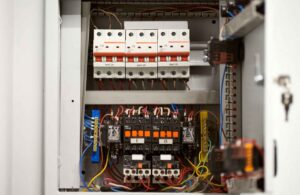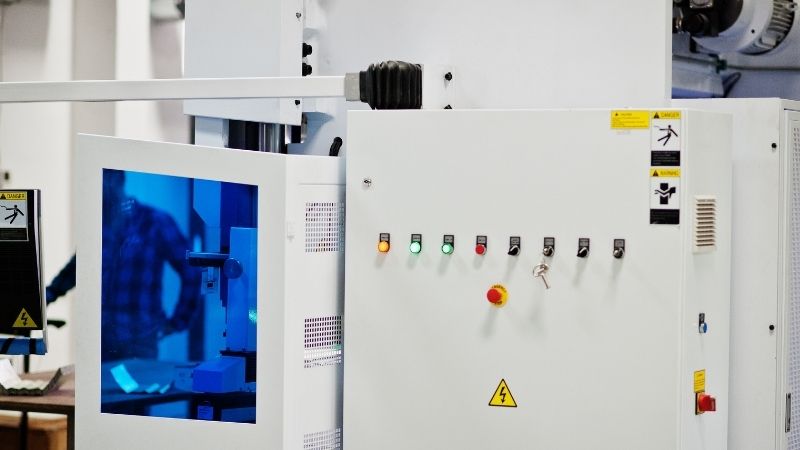RTD dan Termokopel: Sensor Penting untuk Otomasi Industri
Apakah Anda seorang teknisi berpengalaman atau baru mengenal bidang ini, memahami fungsi, keuntungan, dan aplikasi sensor ini akan meningkatkan kemampuan Anda untuk menerapkan solusi pemantauan suhu yang efektif.
Daftar isi
Apa itu RTD dan Bagaimana Cara Kerjanya?
Detektor Suhu Resistansi (RTD) adalah detektor suhu resistansi presisi Sensor digunakan untuk mengukur suhu dengan mengkorelasikan resistansi elemen RTD dengan suhu. RTD, yang biasanya terbuat dari platinum murni, nikel, atau tembaga, menawarkan akurasi dan stabilitas tinggi, sehingga sangat diperlukan dalam berbagai aplikasi industri.
Bagaimana RTD Mengukur Suhu
RTD beroperasi berdasarkan prinsip bahwa resistansi listrik logam tertentu berubah secara terduga seiring dengan suhu. Saat suhu meningkat, resistansi elemen RTD juga meningkat. Perubahan ini diukur dan diubah menjadi pembacaan suhu, sering kali melalui Sistem Pemrosesan Akhir (PLC) kartu masukan atau sistem pemantauan suhu lainnya.
Jenis Konfigurasi RTD
RTD tersedia dalam konfigurasi kabel yang berbeda—2-kabel, 3-kabel, dan 4-kabel—masing-masing menawarkan tingkat akurasi dan kompensasi yang berbeda untuk resistansi kabel utama. RTD 3-kabel umumnya digunakan dalam pengaturan industri karena memberikan keseimbangan yang baik antara kompleksitas dan akurasi.
Bagaimana RTD Dibandingkan dengan Termokopel dalam Pengukuran Suhu?
Dalam hal penginderaan suhu, RTD dan termokopel adalah dua pesaing utama. Memahami perbedaan keduanya adalah kunci untuk memilih sensor yang tepat untuk aplikasi Anda.
Akurasi dan Stabilitas
RTD terkenal karena akurasinya yang unggul dan stabilitas jangka panjangnya dibandingkan dengan termokopel. RTD biasanya menawarkan toleransi ±0,1°C, sehingga ideal untuk aplikasi yang memerlukan kontrol suhu yang presisi.
Kisaran Suhu
Meskipun RTD sangat baik untuk berbagai suhu, termokopel unggul dalam mengukur suhu yang sangat tinggi atau rendah, sering kali di luar kisaran yang dapat ditangani RTD. Misalnya, termokopel Tipe K dapat mengukur suhu hingga 1.800°C, sedangkan RTD umumnya terbatas pada sekitar 850°C.
Waktu Respon
Termokopel umumnya memiliki waktu respons yang lebih cepat karena konstruksinya yang lebih sederhana, membuatnya cocok untuk proses dinamis di mana perubahan suhu cepat perlu dideteksi dengan cepat.
Faktor Apa yang Mempengaruhi Toleransi Sensor RTD?
Toleransi sensor RTD mengacu pada keakuratan dan keandalannya dalam mengukur suhu. Beberapa faktor dapat memengaruhi toleransi RTD, yang memastikan pemantauan suhu yang tepat.
Kualitas Bahan
Kemurnian elemen RTD, yang sering kali berupa platinum, secara signifikan memengaruhi toleransinya. Material dengan kemurnian tinggi menunjukkan perubahan resistansi yang lebih dapat diprediksi seiring dengan suhu, sehingga meningkatkan akurasi.
Kalibrasi
Kalibrasi rutin memastikan bahwa sensor RTD mempertahankan keakuratannya dari waktu ke waktu. Kalibrasi melibatkan perbandingan hasil pembacaan RTD dengan standar suhu yang diketahui dan penyesuaian bila perlu.
Kondisi Lingkungan
Faktor-faktor seperti gangguan listrik, getaran, dan suhu sekitar dapat memengaruhi kinerja RTD. Praktik pemasangan dan pelindungan yang tepat membantu mengurangi dampak ini, sehingga toleransi sensor tetap terjaga.
Apa Peran Kabel dalam Kinerja Sensor RTD?
Pengkabelan sensor RTD berperan penting dalam memastikan pengukuran suhu yang akurat. Jumlah kabel dan kualitasnya dapat memengaruhi kinerja dan keandalan sensor.
Konfigurasi Kawat
RTD tersedia dalam konfigurasi 2-kawat, 3-kawat, dan 4-kawat:
- RTD 2-Wire merupakan yang paling sederhana, tetapi lebih rentan terhadap kesalahan akibat resistansi kabel utama.
- RTD 3-Wire menawarkan kompensasi yang lebih baik untuk resistansi kabel utama, memberikan akurasi yang lebih baik.
- RTD 4-Wire memberikan akurasi tertinggi dengan menghilangkan sepenuhnya resistansi kabel utama dari pengukuran.
Bahan dan Kualitas Kawat
Penggunaan kabel platinum berkualitas tinggi memastikan perubahan resistansi minimal yang tidak terkait dengan variasi suhu. Selain itu, pelindung kabel yang tepat dapat mencegah gangguan listrik memengaruhi pembacaan sensor.
Praktik Instalasi
Pemasangan yang tepat, termasuk penggunaan sumur termal, dapat melindungi sensor RTD dari faktor lingkungan dan tekanan mekanis, menjaga integritas sambungan kabel dan kinerja sensor secara keseluruhan.
Bagaimana PLC Terintegrasi dengan Sensor RTD dalam Otomasi Industri?
Pengontrol Logika yang Dapat Diprogram (PLC (Sistem Kontrol PLC)) merupakan bagian penting dari sistem otomasi industri modern, dan integrasinya yang lancar dengan sensor RTD sangat penting untuk pemantauan dan pengendalian suhu yang efektif.
Menghubungkan RTD ke PLC
Sensor RTD terhubung ke PLC melalui kartu input yang dirancang untuk menginterpretasikan perubahan resistansi RTD menjadi data suhu yang bermakna. Modul input ini sering kali dilengkapi kemampuan input analog untuk menangani sifat pengukuran suhu yang berkelanjutan.
Pengolahan dan Pengendalian Data
Setelah terhubung, PLC memproses data suhu untuk membuat keputusan secara real-time. Misalnya, jika suhu melebihi titik yang ditetapkan, PLC dapat memicu tindakan seperti mengaktifkan sistem pendingin atau menyesuaikan kecepatan motor untuk mempertahankan kondisi optimal.
Meningkatkan Keandalan Sistem
Mengintegrasikan RTD dengan PLC memungkinkan strategi pemantauan dan kontrol yang canggih, meningkatkan keandalan dan efisiensi proses industri secara keseluruhan. Selain itu, PLC dapat mencatat data suhu untuk tujuan kalibrasi dan pemeliharaan prediktif, sehingga mengurangi waktu henti dan biaya operasional.
Pertanyaan yang Sering Diajukan
Apa keuntungan utama menggunakan RTD dibandingkan termokopel?
RTD menawarkan akurasi yang lebih tinggi dan stabilitas jangka panjang yang lebih baik dibandingkan dengan termokopel, menjadikannya ideal untuk aplikasi yang memerlukan pengukuran suhu yang tepat.
Bagaimana konfigurasi kabel memengaruhi kinerja RTD?
Konfigurasi kabel (2-kabel, 3-kabel, atau 4-kabel) memengaruhi keakuratan pembacaan suhu dengan mengimbangi resistansi kabel utama. Lebih banyak kabel umumnya memberikan keakuratan yang lebih baik.
Bisakah RTD mengukur suhu yang sangat tinggi seperti termokopel?
RTD memiliki rentang suhu yang lebih terbatas dibandingkan dengan termokopel. Meskipun cocok untuk sebagian besar aplikasi industri, termokopel lebih disukai untuk mengukur suhu yang sangat tinggi atau rendah.
Seberapa sering sensor RTD harus dikalibrasi?
Kalibrasi rutin disarankan untuk menjaga akurasi, biasanya dilakukan setiap tahun atau seperti yang ditentukan oleh produsen atau standar industri.
Dukung proyek Anda dengan PLC Omron, Mitsubishi, Schneider baru dan asli – tersedia sekarang!
Kesimpulan
- RTD adalah sensor suhu yang sangat akurat dan stabil, ideal untuk aplikasi industri yang presisi.
- Termokopel menawarkan rentang suhu yang lebih luas dan waktu respons yang lebih cepat tetapi kurang akurat dibandingkan RTD.
- Konfigurasi kawat (2-kawat, 3-kawat, 4-kawat) memainkan peran penting dalam akurasi pengukuran RTD.
- PLC terintegrasi secara mulus dengan sensor RTD, memungkinkan pemantauan dan kontrol suhu yang canggih dalam sistem otomasi.
- Kalibrasi rutin dan praktik pemasangan yang tepat sangat penting untuk menjaga keakuratan dan keandalan sensor RTD.
Dengan memahami fungsionalitas dan aplikasi RTD dan termokopel, para profesional di sektor otomasi industri dapat membuat keputusan yang tepat untuk meningkatkan sistem pemantauan suhu mereka, memastikan efisiensi dan keandalan dalam operasi mereka.
Sedang mencari PLC baru dan asli untuk proyek Anda? Di Kwoco, kami menyediakan PLC terbaru dari merek-merek ternama seperti Omron, Mitsubishi, Dan Bahasa Inggris SchneiderBerbelanja dengan percaya diri—pengiriman cepat, kualitas terjamin! Beli Sekarang
Hubungi kami
Cukup isi nama, alamat email, dan deskripsi singkat pertanyaan Anda dalam formulir ini. Kami akan menghubungi Anda dalam waktu 24 jam.
Kategori Produk
Produk Penjualan Panas
Anda Mungkin Juga Menemukan Topik Ini Menarik

10 Kode Alarm Servo Drive Omron yang Umum Dijelaskan
Sebagai teknisi di Kwoco dengan pengalaman bertahun-tahun dalam otomasi industri, saya telah bekerja secara ekstensif dengan penggerak servo Omron. Selama bertahun-tahun, saya telah menemukan berbagai kode alarm yang dapat menghentikan operasi jika tidak segera ditangani. Memahami kode-kode ini sangat penting untuk menjaga kelancaran operasi dan meminimalkan waktu henti.

Selami Lebih Dalam Kerjasama Sukses Kwoco dengan Perusahaan Publik Jepang
Menyelami Lebih Dalam Kerjasama Sukses Kwoco dengan Perusahaan Publik Jepang Pernahkah Anda mempertanyakan apakah pemasok baru dapat

Apa itu Panel Kontrol Listrik? Penjelasan Penting
Panel kontrol listrik merupakan komponen penting dalam otomasi industri, yang berfungsi sebagai pusat kendali dan pemantauan berbagai perangkat listrik. Artikel ini membahas dasar-dasar panel kontrol listrik, komponen-komponennya, dan signifikansinya dalam memastikan operasi yang efisien dan aman dalam lingkungan industri.






